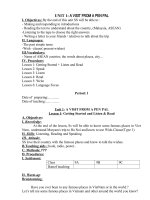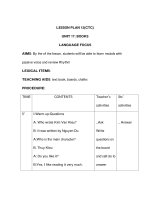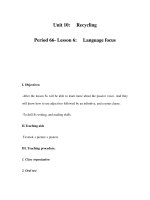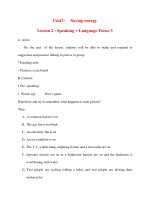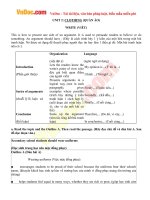ENGLISH 9 WEEK 6 P11-12 UNIT 2 WRITE LANGUAGE FOCUS
Bạn đang xem bản rút gọn của tài liệu. Xem và tải ngay bản đầy đủ của tài liệu tại đây (152.06 KB, 9 trang )
Date of preparing: 7/10/2020
Period 11
Unit 2 : Clothing
Lesson 5: Write
A.The aims of the lesson
1. Knowledges
+ The aims: By the end of the lesson , Ss will be able to write an exposition,
presenting one side of an argument.
+ Vocabulary: - Words about clothing
+ Grammar: - Present simple.
- Firstly, secondly, thirdly ...
2. Skills : Listening, writing skills and grammar
3. Attitude: - Help ss to have good consciousness in order to practice writing an
argument
B. Preparations
1.Teacher : posters, computer, projector, speaker
2. Students: Unit 1 Write
C. Methods:
- Model-Talk-Practice, individual work, pair work
- Some techniques can be used: Chatting, What and where,
D. Procedure:
I.Organization: ( 1 minute)
- Greeting: Good morning!
- Who’s absent today?
Class
Date of teaching
Absent students
9A
12/10
9B
13/10
II. warm up : (2’)
Chatting about students, clothes .
1. Do you like wearing jeans ? why / why
not ?
2. What do you often wear to a party ? / why ?
- Remark and correct mistakes if any .
- Lead in the new lesson .
III .New lesson 39’
Step1. Pre-writing : 12’)
1.Vocabulary: - Elicit – Model – Repeat Copy – Check: meaning, stress, pronunciation
Introduce the aims of the lesson to Ss and
some new words :
- to ‘argue ( situation ): thuyết phục
- Discuss answering the questions.
- Listen carefully .
- Guessing the words
- Repeat in chorus and
individually .
- Guess its meanings and copy .
- to con’clude ( Example ) kết luận
- to en’courage ( form – courage ) cổ vũ
- to bear one,s name ( example )mang tên
- self – ‘confident = sure
- constrained + not natural / forced/ too
controlled
- equal ( example)
- practical ( translation )
- freedom of choice ( translation )
* Checking technique :
What and where
- Ask Ss some questions about an
argumentative writing :
1. How many parts does an argument have ?
2. What does the writer do in each part of an
argument
3. What words or phrases should be used in
each part of an argument ?
- Correct mistakes if any and give the form of
an argumentative writing : ( in text book )
+ Tell them to read them carefully .
- Read the model “ Outline A and ask Ss to
answer these questions :
1. What is the writer,s point of view ?
2. What argument does the writer present?
3. What does the writer write to sum up the
argument
- Call on some Ss to answer the questions and
give the correct answers :
1. The writer,s point of view is “ Secondary
school should wear uniform “
2. Wearing uniform ( writer presents
arguments )
- Encourages Ss to be proud of their school
because the uniforms bear their school, name .
- Help the Ss feel equal in many ways ,
whether they are rich or poor .
- Is practical . Ss do not need to think what to
wear everyday .
3. Ss in secondary school should wear uniform
.
- Ask Ss to read the writing carefully before
writing their ideas .
Step 2. While writing :(20’)
- Ask Ss to look at Outline B and use the
.
-Ss come to the board and write the
English words again in the right
bubbles.
Work in pairs to answer the
questions
- Demonstrate in front of class.
Read carefully and answer the
questions
- Report in front of class.
- Read them carefully and write in
their notebooks .
I think it is desirable( đáng khát khao)
for secondary school students to wear
casual clothes when they are at school.
Firstly, casual clothes make all students
information from the three questions above in
Outline A to discuss in pairs and write and
argument writing in their notebooks .
- Go around and provide help if necessary and
correct common mistakes
- Call on some Ss to read their writing aloud .
- Correct mistake if any and give suggested
writing
( using subordinate board )
feel comfortable. They don't feel
constrainted ( ép buộc) to wear uniform
that they don not like.
Secondly, for one thing, casual clothes
can also give students freedom of
choice. They can choose what sizes,
colors, and fashions of clothing they
love. And for the other, parents do not
worry about their clothes because their
children can wear any clothing to school
as long as it is clean and tidy. It can be
said it is the positive aspect for the poor
people in the present difficult economic
condition.
Finally, casual clothes can make
students feel self-confident when they
are in their favorite clothes. And what's
more it makes the school more colorful
and lively.
In conclusion, in my opinion, all the
secondary school students should wear
casual clothes.
Step3 . Post – writing : (7’)
- Ask Ss to exchange their writings and correct
mistakes .
- Write some common mistakes on the board .
- Tell Ss to read their writings aloud .
* Game “ Classification “
- Give a list of words that belong to two ideas - Compare with a friend to correct
mistakes .
“ for or against “ about wearing uniform :
- Listen and copy .
equal , comfortable , self-confident , proud ,
practical , colorful , uniform , casual clothes ,
lively
For
Against
………………………
- Tell Ss to complete the exercise and correct
mistakes
IV.Summary (2’) Writing an exposition.
V.Home work :(1’)
1. Learn by heart new words .
2. Rewrite the writing in their notebooks .
3. Prepare the next lesson: Unit 2 Language
focus
* Evaluation :
...........................................................................................................................................
...........................................................................................................................................
...........................................................................................................................................
...........................................................................................................................................
...........................................................................................................................................
Date of preparing: 7/10/2020
Period: 12
Unit 2 : Clothing
Lesson 6: Language focus
A.The aims of the lesson
1. Knowledges
+ The aims: By the end of the lesson, Ss will be able to consolidate the present
perfect with Since, For , Yet , Already .
- The present perfect and the past simple and the passive with ordinary verbs and
modal verbs.
- Test 15’
+ Vocabulary: reunification palace, vegetarian, elephant, durian
+ Grammar: - The present perfect and the past simple and the passive with ordinary
verbs and modal verbs.
2. Skills : Listening, writing skills and grammar
3. Attitude: - Help ss to have good consciousness in order to do exercises with the
present perfect and the passive
B. Preparations
1.Teacher : posters, computer, projector, speaker
2. Students: Unit 1 Write
C. Methods:
- Model-Talk-Practice, individual work, pair work
- Some techniques can be used: Pelmanism, Classification, Chatting, What and where,
D. Procedure:
I.Organization: ( 1 minute)
- Greeting: Good morning!
- Who’s absent today?
Class
Date of teaching
Absent students
9A
13/10
9B
17/10
Teacher’ activities
II. WARM UP (3 minutes)
Pelmanism:
- Prepare ten cards with numbers (from 1 to
10) on one side and the verbs on the other.
- Stick the cards on the board so that the
students can only see the numbers, make
sure the verbs are mixed up.
- Divide the class into two teams. Each
team chooses two numbers.
- Turn the cards over, if they match: e.g.
run - ran; that the team gets one mark.
If not, turn the cards over again and ask the
next team to continue.
- Go until all the cards are turned over. The
team which has more marks will win the
game.
III. NEW LESSON (24 minutes)
1. The Present Perfect: 12’
Ex 1:
* Presenting structures:
- Ask sts to look at the dialogue on page 19.
- Elicit from sts : Usage of The Present
Perfect: * The Present Perfect is used to
talk about something which started in the
past and continues up to the present .We
often use for and since with the present
perfect tense.
Form: S + have/has + PP
For + a period of time
Since + a point of time
* Practice :
- Ask sts to use the information in the table
on page 20 to make similar dialogues. Then
practice with their partner.
Suggested dialogues :
b) A: Come and see my photo album.
B: Lovely! Who’s this boy?
A: Ah! It’s Quang, my brother's friend.
B: How long have you known him?
Students’ activities
- Play a game
do
visit
go
see
eat
play
visited
played
done
gone
eaten
seen
1. The Present Perfect
Sts to use the information in the table on
page 20 to make similar dialogues.
Then practice with their partner
A: I’ve known him for seven months.
B: Have you seen her recently?
A: No, I haven’t seen him since
January.
He has (+V-ed)
c) A: Come and see my photo album.
B: Lovely! Who’s this girl?
A: Ah! It’s Hoa, my new friend.
B: How long have you know n her?
A: I’ve known her for three weeks.
B: Have you seen her recently?
A: No, I haven’t seen her since Monday.
She has ( +V-ed ).
- Ask sts to work in pairs to practice the
dialogues.
- Tell students they can also ask each other
about themselves on this topic_ how long
they have known each other.
- Teacher goes round the class, taking notes
in order to help correct S’s pronunciation,
intonation, past participle of irregular
verbs.
Ex 2: Review the present perfect with
ALREADY & YET
- Set the scene: You and your friend are
visiting Ho Chi Minh City. Look at the
notes, there are things you have done, and
some things you haven’t done, what are
they?
- Elicit from students.
I have seen Giac Lam Pagoda.
I have eaten Chinese and French food.
I haven’t seen Unification Palace, Zoo
and Botanical
Gardent, I haven’t tried Vietnam
vegetarian.
- Ask students to look at the dialogue
(LF.2) on page 20.
→ Elicit from students the use and the
position of already and yet in the sentence.
- Ask students to practice the dialogue in
pairs.
*Practice: (LF. 2)
- Teacher goes round the class to takes
Example:
A: How long have you known Tam?
B: I have known her since last week.
2. The present perfect with ALREADY
& YET :
- ALREADY is used in affirmative
sentences.
Position: mid sentence
- YET is use in the negative sentences
and questions
Position: end of the sentence
* Language Focus 2 .
Examples:
A: Have you seen the Reunification
Palace yet?
B: No, I haven’t.
A: Have you tried French food?
B: No, I haven’t.
notes mistakes students have made of the
delayed correction.
Ex 3. Review present perfect with EVER
- Set the scene: Tom and Mary are talking
to each other about places they have been
to.
- Ask students to look at the dialogue.
→Elicit from the students:
+ We use the past simple to talk about
definite time.
e.g. I went to France last year/ two months
ago/ in 1992.
+ We use the present perfect to talk about
indefinite past time.
e.g. Have you ever ( at some time in your
life) been to Italy?
- Run through the vocabulary in exercise 3
on page 20.
Read a comic
Use a computer
Go to the market
Play volleyball
Go to Singapore
Go to the
movies
See an elephant
Eat durian
- Students work in pairs to practice asking
and answering about each of items in the
box.
Example :
A: Have you ever read a comic?
B: Yes, I have.
A: When did you last read one?
B: This morning.
2. Present perfect with EVER:
Tom: Have you ever been to
Ireland?
Mary: No, I haven’t.
Tom: Have you ever been to
France?
Mary: Yes, I have.
Tom: When did you go there?
Mary: Two years ago.
- EVER: is used in questions
Meaning: có bao giờ
Students to practice the dialogue in
pairs.
2. The Passive:
1. The passive forms of present perfect,
simple present, simple past, and simple
future.
2. The Passive: 12’
Ex 4. Review the passive forms of present
perfect, simple present, simple past, and
simple future.
- Ask students to look at the example in the
exercise 4 on page 21.
- Elicit from students the passive forms of
the present perfect, simple present, past * Language Focus 4.
simple, simple future.
Answers:
a) Jeans cloth was made completely
BE + PAST
PARTICIPLE
- Ask students to do the exercise.
from cotton in the 18th century.
b) Rice is grown in tropical countries.
c) Five million bottles of champagne
will be produced in France next year.
d) A new style of jeans has just been
introduced in the USA.
e) Two department stores have been
built this year
Ex 5. Passive forms of modal verbs and
Ex 5. The passive forms of modal verbs the verb patterns HAVE TO/ BE
and the verb patterns HAVE TO/ BE GOING TO:
GOING TO
- Elicit from students the modal verbs,
must, can, should, might and the patterns * Language Focus 5.
Students to complete the sentences,
have to/ be going to
using the passive forms
- form:
Answers:
- modal verbs + be + PP
a) The problem can be solved.
- have to/ be going to + be + PP
- Ask students to do exercise 5 on page 21. b) Experiment on animals should be
stopped.
c) Life might be found on another
planet.
d) All the schools in the city have to be
improved
* Further Practice :
e) A new bridge is going to be built in
1. Have you ever .........................
the area.
2. A new road .........................
3. You can .............................
4. A party is going to .................
5. The Spring Fair ...................
IV. SUMMARY (1 minutes)
- ALREADY and YET in the present perfect tense.
- Difference in using the past simple and the present perfect tense.
- Passive forms of the present perfect tense, simple present, simple past and simple
future.
Ex: Give some examples.
V. HOMEWORK (1 minutes)
- Ask students to copy the sentences into their notebooks.
- Prepare: Unit 3 Getting stared, Listen and read
* Evaluation:
...........................................................................................................................................
...........................................................................................................................................
...........................................................................................................................................
...........................................................................................................................................

